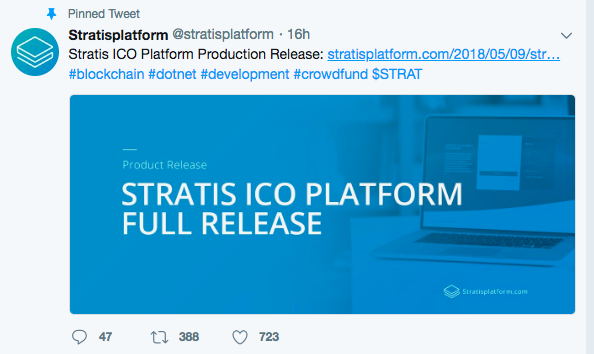Stratis, the powerful and flexible Blockchain-as-a-Service (BaaS) platform designed to meet the needs of real-world enterprise, is a project that sometimes gets criticized for a lack of action or for being a “boring coin”.
But on May 9, 2018, they made an announcement that is sure to garner some excitement and a bit more noise. In keeping with their roadmap, Stratis has now fully released their ICO platform.

Key Features of the Stratis ICO Platform
This announcement comes on the heels of months of anticipation, and represents a significant milestone for the Stratis team. The platform itself is said to be “feature rich” and enables users to deploy an ICO within minutes via the “deploy to Azure” button.
According to an official blog post, the platform boasts five key features and benefits:
- A design that allows for high degrees of customization, the platform easily conforms to various branding requirements.
- With the help of Changelly, ICO contributors can fund projects (on Stratis) in USD, BTC, STRAT, and 50 other digital currencies.
- Know Your Customer (KYC) and anti-money laundering (AML) services are integrated directly into the platform via Onfido.
- The use of “hierarchical deterministic wallets” gives users a degree of security by ensuring funds are not simply stored on the server.
- There are no fees associated with the use of the Stratis ICO platform, providing a workaround to other (more expensive) crowdfunding options.
The Stratis ICO platform aims to address the deficiencies of existing ICO options. For the most part, other ICO platforms either create difficult DIY scenarios, present uncertain security risks or charge users a higher fee.
Stratis has set out to do things better. The foundational idea behind the Stratis ICO platform is to build something that is intuitive and make it easier for non-technical users to invest in ICOs.
According to CEO Chris Trew:
At Stratis, we are focused on making blockchain simple and accessible. With this platform, we’ve drastically improved the user experience for both ICO issuers and contributors.
Upcoming ICOs on Stratis
There are a number of ICOs already rumored to be lining up on Stratis. One of the first confirmed is GLUON. GLUON is a project that was vetted and actively brought through the door by the Stratis team.
In the future, the ICO market on Stratis will be open for anyone interested in hosting their own ICO, so doing your own due diligence will (as always) be imperative. Other projects are not far behind GLUON, as some have already expressed interest in using the Stratis ICO platform.

What’s more, the news surrounding Stratis doesn’t end with the ICO platform. There will be a smart contract component to this platform, and the Alpha version of that software will be released on May 16.
For anyone interested to learn more about Stratis’ C# smart contract approach, Stratis developer Jordan Andrews made a detailed presentation at Blockchain Expo 2018.
Concluding Thoughts
Any platform like Stratis is a potential sleeping giant, but knowing which ones are destined for NEO or even Ethereum-style ascents is very difficult to say.
What we can say with certainty is this: Stratis has successfully met a critical milestone, smart contracts (even if Alpha) are around the corner, and not too far down the track lie finalized Masternodes (to aid decentralization) and the Breeze protocol (helping to ensure privacy).
These developments could be a real turning point for Stratis.
Some may have been left disappointed by their price actually falling slightly after the May 9 launch, but the ICO platform release has arguably been priced into STRAT for a while now.
The good news is that Stratis has a lean and focused team that seems to be really hitting their stride. For those focused solely on price, compare what’s currently under construction on Stratis with the top 20 coins; do that, and it quickly becomes clear there is huge room for growth still.
The Stratis ICO platform and associated documentation is now available on GitHub.

